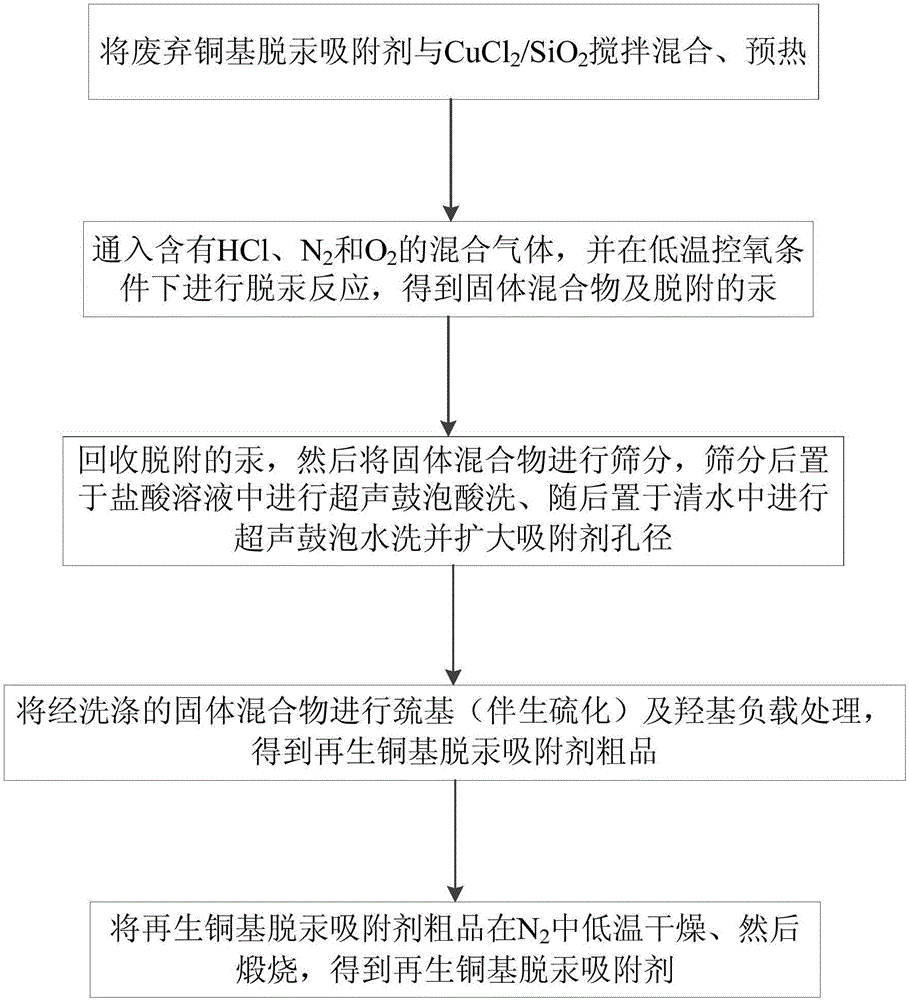Demercuration and regeneration method for copper-based demercuration adsorbent
An adsorbent, mercury removal technology, applied in separation methods, filter regeneration, chemical instruments and methods, etc., can solve the problem of copper-based mercury removal adsorbents that cannot be recycled simple effect
- Summary
- Abstract
- Description
- Claims
- Application Information
AI Technical Summary
Problems solved by technology
Method used
Image
Examples
Embodiment 1
[0053] This embodiment provides a mercury removal and regeneration method for a waste copper-based mercury removal adsorbent, the steps of which are as follows:
[0054] Take the abandoned copper sulfide mercury removal adsorbent with aluminum oxide as the carrier and the low-temperature pyrolysis catalyst in a gas field and mix and preheat in a stirred reactor. The preheating temperature is 50°C and the time is 30 minutes to obtain a preheated mixture; Wherein, the above-mentioned low-temperature pyrolysis catalyst is composed of 90% by mass percentage of copper chloride and 10% by mass of silicon dioxide, and the particle diameter of the silicon dioxide is 4mm. The chlorine molar ratio of copper chloride in the pyrolysis catalyst is 1:2 (ie Hg:Cl=1:2);
[0055] The above-mentioned preheated mixture is placed in a rotary furnace, and then the mixed carrier gas is continuously introduced, and an oxygen-controlled pyrolysis reaction (ie, mercury removal reaction) is carried out...
Embodiment 2
[0062] This embodiment provides a mercury removal and regeneration method for a waste copper-based mercury removal adsorbent, the steps of which are as follows:
[0063] The copper sulfide mercury removal adsorbent and the low-temperature pyrolysis catalyst discarded by the power plant with activated carbon as the carrier are mixed and preheated in a stirred reactor. The preheating temperature is 50 ° C and the time is 30 minutes to obtain a preheated mixture; wherein, The above-mentioned low temperature pyrolysis catalyst is composed of 70% copper chloride by mass percentage and 30% silicon dioxide by mass percentage. The particle diameter of the silicon dioxide is 4mm. The chlorine molar ratio of copper chloride in the catalyst is 1:1 (ie Hg:Cl=1:1);
[0064] The above-mentioned preheated mixture is placed in a rotary furnace, and then the mixed carrier gas is continuously introduced, and an oxygen-controlled pyrolysis reaction (ie, mercury removal reaction) is carried out i...
Embodiment 3
[0070] This embodiment provides a mercury removal and regeneration method for a waste copper-based mercury removal adsorbent, the steps of which are as follows:
[0071] Take the abandoned copper sulfide mercury removal adsorbent with aluminum oxide as the carrier and the low-temperature pyrolysis catalyst in a gas field and mix and preheat in a stirred reactor. The preheating temperature is 50°C and the time is 30 minutes to obtain a preheated mixture; Wherein, the above-mentioned low-temperature pyrolysis catalyst is composed of 90% by mass percentage of copper sulfide and 10% by mass of silicon dioxide, and the particle diameter of the silicon dioxide is 4mm. The sulfur molar ratio of copper sulfide in the decomposing catalyst is 1:2 (ie Hg:S=1:2);
[0072]The above-mentioned preheated mixture is placed in a rotary furnace, and then the mixed carrier gas is continuously introduced, and an oxygen-controlled pyrolysis reaction (ie, mercury removal reaction) is carried out in ...
PUM
| Property | Measurement | Unit |
|---|---|---|
| Particle size | aaaaa | aaaaa |
| Diameter | aaaaa | aaaaa |
Abstract
Description
Claims
Application Information
 Login to View More
Login to View More - R&D
- Intellectual Property
- Life Sciences
- Materials
- Tech Scout
- Unparalleled Data Quality
- Higher Quality Content
- 60% Fewer Hallucinations
Browse by: Latest US Patents, China's latest patents, Technical Efficacy Thesaurus, Application Domain, Technology Topic, Popular Technical Reports.
© 2025 PatSnap. All rights reserved.Legal|Privacy policy|Modern Slavery Act Transparency Statement|Sitemap|About US| Contact US: help@patsnap.com

